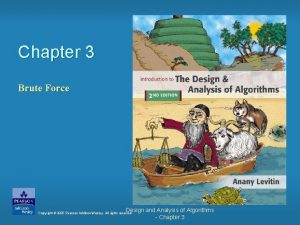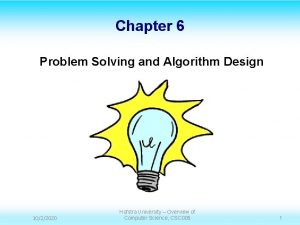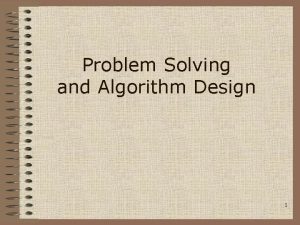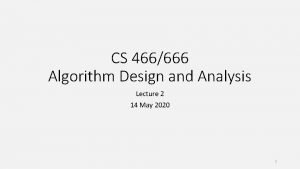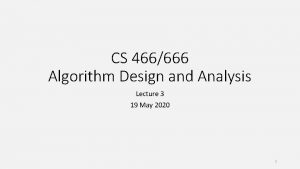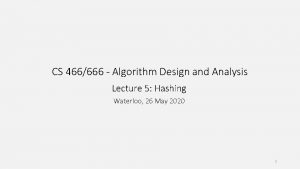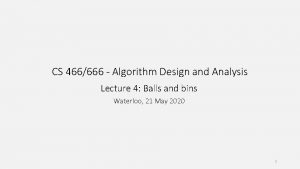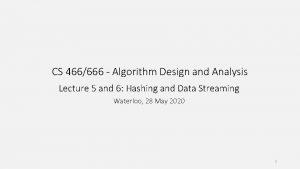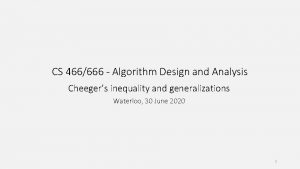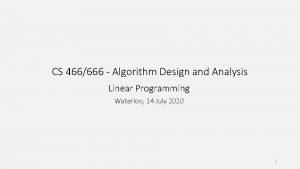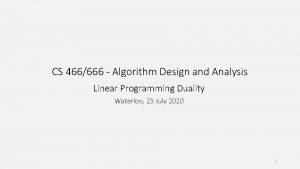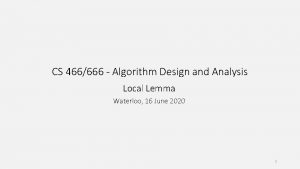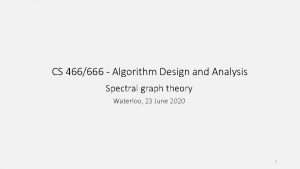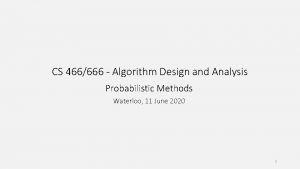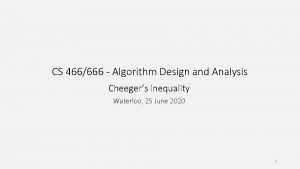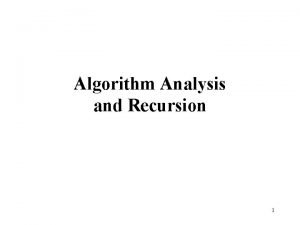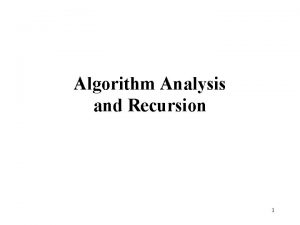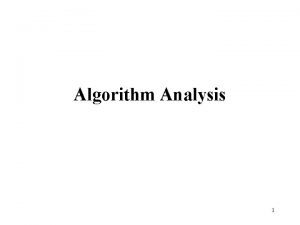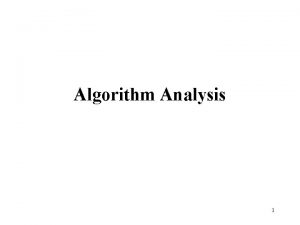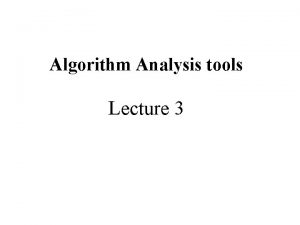CS 466666 Algorithm Design and Analysis Lecture 1





























- Slides: 29

CS 466/666 Algorithm Design and Analysis Lecture 1 12 May 2020 Lap Chi Lau

Today’s Plan Course overview Course administration Short break Karger’s minimum cut algorithm

Setup in Bongo “Picture in picture” for the camera, minimize the size and move to a corner. “Show controls” for the powerpoint, then make it full screen. Unmute to ask questions. Or ask questions in chat box.

First course in algorithms (CS 341) Learn various basic and important techniques in design and analysis of algorithms. • Divide and conquer • Greedy algorithms • Dynamic programming • Local search • Reductions to prove NP-completness They are elegant and insightful and combinatorial Deterministic Output optimal solutions in polynomial time.

Second course in algorithms (CS 466/666) Dealing with NP-complete problems: • Approximation algorithms • Faster exact algorithms Problems in P • Simpler and faster algorithms • Parallel algorithms • Distributed algorithms • Sublinear time/space algorithms • Online algorithms

Modern techniques We will learn techniques from three main areas. 1. Probabilistic 2. Linear algebraic / spectral methods 3. Continuous optimization / linear programming

Randomized Algorithms 30 years of active research Basic tools: Applications: • Concentration inequalities (e. g. Chernoff) • Graph sparsification (fast algorithms) • Algebraic methods (e. g. hashing) • Data streaming (sublinear space) • Random walks • Parallel matching (parallel algorithms) • Probabilistic methods (e. g. local lemma) • Network coding (distributed algorithms) • Random sampling

Linear Algebra / Spectral Methods Treat adjacency matrix as a matrix Topics: • Basic spectral graph theory • Cheeger’s inequality, graph partitioning • Analysis of mixing time of random walks • Think of a graph as an electrical network • Spectral sparsification • Laplacian linear equations s t

Continuous optimization / linear programming Use continuous techniques to solve discrete problems. Topics: • Linear programming, extreme point solutions • General framework to design exact and approximation algorithms • Duality theorem • Multiplicative update method (online computation)

Motivating Example Max s-t flow = max set of edge disjoint s-t paths Min s-t cut = minimum set of edges to disconnect s and t. Example: Classical results: max s-t flow = min s-t cut (max-flow min-cut theorem) polynomial time combinatorial algorithms using augmenting paths. fast algorithm using advanced data structures, Goldberg-Rao

Probabilistic techniques Graph sparsification: random sampling to sparsify the input graph

Linear Programming Formulate the problem as a continuous optimization problem Learn: 1. How to show that there is always an optimal integral solution 2. LP duality theorem => max-flow min-cut theorem 3. How to turn/”round” a fractional solution into an integral solution using random walks!

Spectral techniques Use concepts from electrical networks for graph sparsification s Use sparsification and optimization to compute electrical flows fast Use multiplicative update method to turn electrical flow into LP solution This gives a faster algorithm than Goldberg-Rao in some regime! This is the beginning of a new revolution of using continuous methods for discrete optimization problems. t

Course style Focus on main ideas and basic techniques. Won’t see as many examples as possible, and won’t see the hardest results in the areas. Broader overview of current techniques (useful in other areas as well).

Background Prerequisites: CS 341 (or an equivalent first course in algorithms) Advanced course: content is challenging and pace is fast. Check: practice problems in probability, and course page of 466 Spring 2018.

Course administration Homework 50% 5 assignments. Course project 50% project proposal ~ midterm (~July 13) project report ~ final exam (~Aug 14) No midterm and final exams. Online format: flexible.

Course project Choose a topic of your own interest for a deeper study • algorithms • theoretical/mathematical Basic requirement is to read papers and write a survey/report/summary Original contents are strongly encouraged • different proofs, simpler proofs, unified proofs • some extensions, generalizations, variants Up to two students for undergraduate students. Graduate students must work on their own. Send proposal by mid July, will receive comments and suggestions. Send report by mid August.

Short break Ask questions

Minimum Cut Find a minimum cardinality subset of edges to disconnect the graph. Example:

History

Karger’s algorithm Idea: just choose a random edge to contract! Karger’s Algorithm While there are more than two vertices in the graph choose a uniformly random edge uv and contract the two endpoints Output the edges between the remaining two vertices.

Observations

Theorem

Analysis

Boosting success probability

Improving running time (sketch)

Combinatorial structure

Discussions Minimum k-cut Minimum s-t cut Minimum vertex cut Graph sparsification => near linear time algorithm

Homework Practice problems on probability Read chapter 1 and 2 of Mitzenmacher and Upfal.
 01:640:244 lecture notes - lecture 15: plat, idah, farad
01:640:244 lecture notes - lecture 15: plat, idah, farad Anany levitin
Anany levitin Brute force polynomial evaluation algorithm
Brute force polynomial evaluation algorithm What is input and output design
What is input and output design A star and ao star algorithm
A star and ao star algorithm User interface design in system analysis and design
User interface design in system analysis and design Dialogue design
Dialogue design Advantages of structured analysis
Advantages of structured analysis Fact finding in system analysis and design
Fact finding in system analysis and design Feasibility study in system analysis and design
Feasibility study in system analysis and design Sweep line algorithm cp algorithm
Sweep line algorithm cp algorithm Anchorage length eurocode
Anchorage length eurocode Elemen urban design
Elemen urban design Elements and principles of interior design ppt
Elements and principles of interior design ppt Lecture hall acoustic design
Lecture hall acoustic design Game design lecture
Game design lecture Computer-aided drug design lecture notes
Computer-aided drug design lecture notes Cmos vlsi design lecture notes
Cmos vlsi design lecture notes Exploratory data analysis lecture notes
Exploratory data analysis lecture notes Sensitivity analysis lecture notes
Sensitivity analysis lecture notes Factor analysis lecture notes
Factor analysis lecture notes Analysis of algorithms lecture notes
Analysis of algorithms lecture notes Streak plate
Streak plate Zline 667-36
Zline 667-36 Algorithm design and problem solving
Algorithm design and problem solving Problem solving and algorithm design
Problem solving and algorithm design Kendall and kendall system analysis and design
Kendall and kendall system analysis and design Determining human information requirements
Determining human information requirements Patched up prototype
Patched up prototype Kendall and kendall system analysis and design
Kendall and kendall system analysis and design


